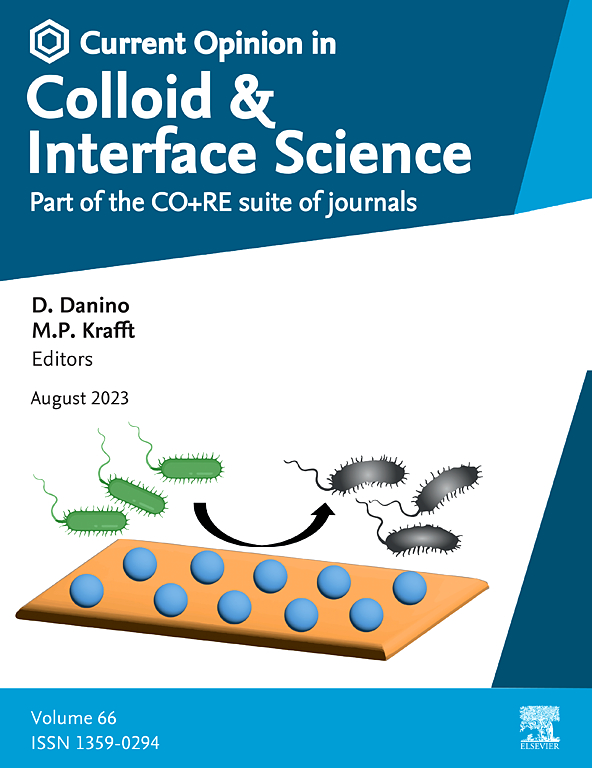Current scenario and future trends on stability issues of perovskite solar cells: A mini review
IF 7
2区 化学
Q1 CHEMISTRY, PHYSICAL
Current Opinion in Colloid & Interface Science
Pub Date : 2025-01-15
DOI:10.1016/j.cocis.2025.101895
引用次数: 0
Abstract
Perovskite solar cells (PSCs) are considered a new paradigm in photovoltaic energy technology due to their extraordinary power conversion capabilities. However, their commercialization is hindered by stability issues. The current understanding of PSC degradation mechanisms focuses on factors such as moisture, oxygen, light, temperature, and electrical bias are comprehensively analyzed in this review article. The essential encapsulation strategies require further refinement for long-standing stability. Material engineering, including compositional tuning and defect passivation, has shown promise in enhancing intrinsic perovskite stability. Interface tuning between the perovskite layer and charge transport materials (hole and electron transport layers) is crucial for suppressing ion migration and charge recombination. Additionally, the advanced characterization techniques offer to dive into the degradation pathways, enabling targeted stability improvements. Despite substantial progress in obtaining higher efficiency in PSCs, it is still challenging to achieve the expected stability in PSCs. The development of novel perovskite materials with enhanced structural stability, improved encapsulation strategies, and an understanding of degradation mechanisms at the molecular level should be the imminent research focus with the development of accelerated testing methodologies and field trials essential for evaluating long-standing performance. PSCs will be a major contributor to renewable energy generation once the stability issues with their structure are erased.
钙钛矿太阳能电池稳定性问题的现状和未来趋势:一个小综述
钙钛矿太阳能电池(PSCs)由于其非凡的功率转换能力而被认为是光伏能源技术的新范例。然而,它们的商业化受到稳定性问题的阻碍。本文对目前对PSC降解机制的认识主要集中在水分、氧气、光、温度和电偏压等因素上进行了综合分析。基本的封装策略需要进一步改进以实现长期的稳定性。材料工程,包括成分调谐和缺陷钝化,已经显示出增强钙钛矿固有稳定性的希望。钙钛矿层和电荷输运材料(空穴和电子输运层)之间的界面调整对于抑制离子迁移和电荷复合至关重要。此外,先进的表征技术可以深入研究降解途径,从而有针对性地提高稳定性。尽管PSCs在获得更高效率方面取得了实质性进展,但要实现预期的PSCs稳定性仍然具有挑战性。开发具有增强结构稳定性、改进封装策略和在分子水平上理解降解机制的新型钙钛矿材料应该是迫在眉睫的研究重点,同时开发加速测试方法和现场试验对于评估长期性能至关重要。一旦PSCs结构的稳定性问题被消除,它将成为可再生能源发电的主要贡献者。
本文章由计算机程序翻译,如有差异,请以英文原文为准。
求助全文
约1分钟内获得全文
求助全文
来源期刊
CiteScore
16.50
自引率
1.10%
发文量
74
审稿时长
11.3 weeks
期刊介绍:
Current Opinion in Colloid and Interface Science (COCIS) is an international journal that focuses on the molecular and nanoscopic aspects of colloidal systems and interfaces in various scientific and technological fields. These include materials science, biologically-relevant systems, energy and environmental technologies, and industrial applications.
Unlike primary journals, COCIS primarily serves as a guide for researchers, helping them navigate through the vast landscape of recently published literature. It critically analyzes the state of the art, identifies bottlenecks and unsolved issues, and proposes future developments.
Moreover, COCIS emphasizes certain areas and papers that are considered particularly interesting and significant by the Editors and Section Editors. Its goal is to provide valuable insights and updates to the research community in these specialized areas.

 求助内容:
求助内容: 应助结果提醒方式:
应助结果提醒方式:


